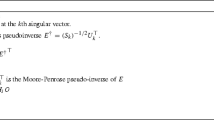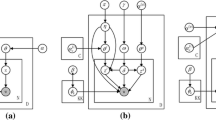Abstract
Topic modeling is a generalization of clustering that posits that observations (words in a document) are generated by multiple latent factors (topics), as opposed to just one. The increased representational power comes at the cost of a more challenging unsupervised learning problem for estimating the topic-word distributions when only words are observed, and the topics are hidden. This work provides a simple and efficient learning procedure that is guaranteed to recover the parameters for a wide class of multi-view models and topic models, including latent Dirichlet allocation (LDA). For LDA, the procedure correctly recovers both the topic-word distributions and the parameters of the Dirichlet prior over the topic mixtures, using only trigram statistics (i.e., third order moments, which may be estimated with documents containing just three words). The method is based on an efficiently computable orthogonal tensor decomposition of low-order moments.

Similar content being viewed by others
Notes
The technique of [23] is actually attributed to Robert Jennrich.
By additive noise, we mean a model in which \({\varvec{x}}_v = {\varvec{O}}^{(v)}{\varvec{h}}+ {\varvec{\eta }}_v\) where \({\varvec{\eta }}_v\) is a zero-mean random vector independent of \({\varvec{h}}\).
References
Achlioptas, D., McSherry, F.: On spectral learning of mixtures of distributions. Eighteenth Annual Conference on Learning Theory, pp. 458–469. Springer, Bertinoro (2005)
Anandkumar, A., Chaudhuri, K., Hsu, D., Kakade, S.M., Song, L., Zhang, T.: Spectral methods for learning multivariate latent tree structure. Adv. Neural Inf. Process. Syst. 24, 2025–2033 (2011)
Anandkumar, A., Foster, D.P., Hsu, D., Kakade, S.M., Liu, Y.K.: A spectral algorithm for latent Dirichlet allocation. Adv. Neural Inf. Process. Syst. 25, 917–925 (2012)
Anandkumar, A., Foster, D.P., Hsu, D., Kakade, S.M., Liu, Y.K.: Two SVDs suffice: spectral decompositions for probabilistic topic models and latent Dirichlet allocation (2012). arXiv:1204.6703v1
Anandkumar, A., Ge, R., Hsu, D., Kakade, S.M., Telgarsky, M.: Tensor decompositions for learning latent variable models. J. Mach. Learn. Res. (2014). To appear.
Anandkumar, A., Hsu, D., Kakade, S.M.: A method of moments for mixture models and hidden Markov models. In: Twenty-Fifth Annual Conference on Learning Theory, vol. 23, pp. 33.1-33.34 (2012)
Ando, R., Zhang, T.: Two-view feature generation model for semi-supervised learning. In: Twenty-Fourth International Conference on Machine Learning, pp. 25–32 (2007)
Arora, S., Ge, R., Moitra, A.: Learning topic models – going beyond SVD. In: Fifty-Third IEEE Annual Symposium on Foundations of Computer Science, pp. 1–10 (2012)
Arora, S., Ge, R., Moitra, A., Sachdeva, S.: Provable ICA with unknown Gaussian noise, with implications for Gaussian mixtures and autoencoders. Adv. Neural Inf. Process. Syst. 25, 2375–2383 (2012)
Arora, S., Kannan, R.: Learning mixtures of separated nonspherical Gaussians. Ann. Appl. Probab. 15(1A), 69–92 (2005)
Belkin, M., Sinha, K.: Polynomial learning of distribution families. In: Fifty-First Annual IEEE Symposium on Foundations of Computer Science, pp. 103–112 (2010)
Blei, D.M., Ng, A., Jordan, M.: Latent Dirichlet allocation. J. Mach. Learn. Res. 3, 993–1022 (2003)
Canny, J.: GaP: A factor model for discrete data. In: Proceedings of the Twenty-Seventh Annual International ACM SIGIR Conference on Research and Development in Information Retrieval, pp. 122–129 (2004)
Cardoso, J.F., Comon, P.: Independent component analysis, a survey of some algebraic methods. In: IEEE International Symposium on Circuits and Systems, pp. 93–96 (1996)
Chang, J.T.: Full reconstruction of Markov models on evolutionary trees: identifiability and consistency. Math. Biosci. 137, 51–73 (1996)
Chaudhuri, K., Kakade, S.M., Livescu, K., Sridharan, K.: Multi-view clustering via canonical correlation analysis. In: Twenty-Sixth Annual International Conference on Machine Learning, pp. 129–136 (2009)
Chaudhuri, K., Rao, S.: Learning mixtures of product distributions using correlations and independence. In: Twenty-First Annual Conference on Learning Theory, pp. 9–20 (2008)
Comon, P., Jutten, C.: Handbook of Blind Source Separation: Independent Component Analysis and Applications. Academic Press, Waltham (2010)
Dasgupta, S.: Learning mixutres of Gaussians. In: Fortieth Annual IEEE Symposium on Foundations of Computer Science, pp. 634–644 (1999)
Dasgupta, S., Schulman, L.: A probabilistic analysis of EM for mixtures of separated, spherical Gaussians. J. Mach. Learn. Res. 8, 203–226 (2007)
Frieze, A.M., Jerrum, M., Kannan, R.: Learning linear transformations. In: Thirty-Seventh Annual Symposium on Foundations of Computer Science, pp. 359–368 (1996)
Griffiths, T.: Gibbs sampling in the generative model of latent Dirichlet allocation. Tech. rep., Stanford University (2002)
Harshman, R.: Foundations of the PARAFAC procedure: model and conditions for an ‘explanatory’ multi-mode factor analysis. Tech. rep., UCLA Working Papers in Phonetics (1970)
Hitchcock, F.: The expression of a tensor or a polyadic as a sum of products. J. Math. Phys. 6, 164–189 (1927)
Hitchcock, F.: Multiple invariants and generalized rank of a p-way matrix or tensor. J. Math. Phys. 7, 39–79 (1927)
Hofmann, T.: Probabilistic latent semantic indexing. In: Proceedings of the Twenty-Second Annual International ACM SIGIR Conference on Research and Development in Information Retrieval, pp. 50–57 (1999)
Hotelling, H.: The most predictable criterion. J. Educ. Psychol. 26(2), 139–142 (1935)
Hsu, D., Kakade, S.M.: Learning mixtures of spherical Gaussians: moment methods and spectral decompositions. In: Fourth Innovations in Theoretical Computer Science (2013)
Hsu, D., Kakade, S.M., Zhang, T.: A spectral algorithm for learning hidden Markov models. J. Comput. Syst. Sci. 78(5), 1460–1480 (2012). http://www.sciencedirect.com/science/article/pii/S0022000012000244
Jutten, C., Herault, J.: Blind separation of sources, part I: an adaptive algorithm based on neuromimetic architecture. Signal Process. 24, 1–10 (1991)
Kakade, S.M., Foster, D.P.: Multi-view regression via canonical correlation analysis. In: Twentieth Annual Conference on Learning Theory, pp. 82–96 (2007)
Kalai, A.T., Moitra, A., Valiant, G.: Efficiently learning mixtures of two Gaussians. In: Forty-second ACM Symposium on Theory of Computing, pp. 553–562 (2010)
Kannan, R., Salmasian, H., Vempala, S.: The spectral method for general mixture models. SIAM J. Comput. 38(3), 1141–1156 (2008)
Kolda, T.G., Bader, B.W.: Tensor decompositions and applications. SIAM Rev. 51(3), 455–500 (2009)
Kruskal, J.B.: Three-way arrays: rank and uniqueness of trilinear decompositions, with application to arithmetic complexity and statistics. Linear Algebra Its Appl. 18(2), 95–138 (1977)
Lee, D.D., Seung, H.S.: Learning the parts of objects by nonnegative matrix factorization. Nature 401, 788–791 (1999)
Leurgans, S., Ross, R., Abel, R.: A decomposition for three-way arrays. SIAM J. Matrix Anal. Appl. 14(4), 1064–1083 (1993)
Moitra, A., Valiant, G.: Settling the polynomial learnability of mixtures of Gaussians. In: Fifty-First Annual IEEE Symposium on Foundations of Computer Science, pp. 93–102 (2010)
Mossel, E., Roch, S.: Learning nonsingular phylogenies and hidden Markov models. Ann. Appl. Probab. 16(2), 583–614 (2006)
Nguyen, P.Q., Regev, O.: Learning a parallelepiped: cryptanalysis of GGH and NTRU signatures. J. Cryptol. 22(2), 139–160 (2009)
Papadimitriou, C.H., Raghavan, P., Tamaki, H., Vempala, S.: Latent semantic indexing: a probabilistic analysis. J. Comput. Syst. Sci. 61(2), 217–235 (2000)
Pearson, K.: Contributions to the mathematical theory of evolution. Philos. Trans. R. Soc. Lond. A 185, 71–110 (1894)
Redner, R.A., Walker, H.F.: Mixture densities, maximum likelihood and the EM algorithm. SIAM Rev. 26(2), 195–239 (1984)
Tucker, L.R.: Some mathematical notes on three-mode factor analysis. Psychometrika 31(3), 279–311 (1966)
Vempala, S., Wang, G.: A spectral algorithm for learning mixtures models. J. Comput. Syst. Sci. 68(4), 841–860 (2004)
Zou, J., Hsu, D., Parkes, D., Adams, R.: Contrastive learning using spectral methods. Adv. Neural Inf. Process. Syst. 26, 2238–2246 (2013)
Acknowledgments
We thank Kamalika Chaudhuri, Adam Kalai, Percy Liang, Chris Meek, David Sontag, and Tong Zhang for valuable insights. We also thank Rong Ge for sharing preliminary results (in [8]) and the anonymous reviewers for their comments, suggestions, and pointers to references. Part of this work was completed while DH was a postdoctoral researcher at Microsoft Research New England, and while DPF, YKL, and AA were visiting the same lab. AA is supported in part by Microsoft Faculty Fellowship, NSF Career award CCF-1254106, NSF Award CCF-1219234, NSF BIGDATA IIS-1251267 and ARO YIP Award W911NF-13-1-0084.
Author information
Authors and Affiliations
Corresponding author
Rights and permissions
About this article
Cite this article
Anandkumar, A., Foster, D.P., Hsu, D. et al. A Spectral Algorithm for Latent Dirichlet Allocation. Algorithmica 72, 193–214 (2015). https://doi.org/10.1007/s00453-014-9909-1
Received:
Accepted:
Published:
Issue Date:
DOI: https://doi.org/10.1007/s00453-014-9909-1




